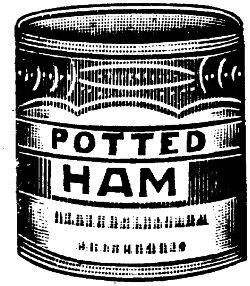Potted ham.
The editor really likes this one. According to Elizabeth Ayrton, her version is a nineteenth century recipe from Suffolk. This recipe is an easier sell then other potted foods to modern sensibilities because it uniquely includes no butter. It uses onions to bind the other ingredients instead. The combination of ham, curry and cider is triumphantly English.

- about 1 Tablespoon unsalted butter
- a generous cup of chopped onion
- about ½ lb chopped ham
- about 1 ½ teaspoon curry powder (more or less depending on its fire)
- scant ¼ teaspoon cayenne (or less, or none, if the curry powder is hot)
- ½ teaspoon paprika
- ½ cup hard cider
- Sweat the onions in the butter over low heat until they soften but do not brown.
- Remove the onions from the heat, mix them with the ham and grind them in a food processor until they roughly resemble coarse hamburger.
- Put the mixture in a heavy pot that is not too big, along with the spices and cider, and simmer uncovered for about 20 minutes. Stir the mixture from time to time: It is not very wet and tends to erupt and scorch if unattended.
- Return the mixture to the food processor and blast it to a paste. Check for salt: You should not need any due to the ham.
- Pot and cover with butter or ghee as usual.
Notes:
- Please alter this recipe. In practice the Editor herself uses more curry. The flavors are strong and invite improvisation. You could use shallots other than onions, add chives or alter the spices in infinite ways. Use what you have got or what you especially like.
- You can substitute red or white wine for the cider but, in this recipe, it is just not the same.
- The amount of cider recommended in the recipe is probably excessive, but scorching is a problem unless you have a commercial stove with a simmer function or are adept with a heat retarder. The Editor usually spoons out some excess liquid before processing the mixture a second time.
- Barbara Kafka is one of many writers who repeat the shibboleth that the British use of curry powder, and British dishes like mulligatawny or kedgeree, are “bowdlerized” or debased Indian recipes. They are not. If these dishes were being improvised for the first time today, they would be considered innovative for their adaptation and reimagination of Indian foodways. Potted ham is another example. Ham, cider, and for that matter curry powder were unknown in India before the arrival of the British.
- The Editor is one of those people who likes Underwood’s Devilled Ham, the breathtakingly unfashionable minced ham in a can. She used to mix it with mayonnaise. This potted ham, however, has inspired bfia to mix it with some kind of curry powder or paste, cayenne, a drip of ale and the mayonnaise. It is a handy concoction when you forgot to go shopping to make starters.
- Eliza Acton seasons her potted ham generously with cayenne, mace and nutmeg but omits the curry, adds a little roast veal and substitutes the more conventional butter for cider and onions. An excellent variation.
- Ever the minimalist, Robin McDouall predictably also eschews curry, and cooks his potted ham like a terrine:
“Take a little of the lean and all of the fat and put them through a mincer. Add made English mustard, powdered mace and nutmeg. Soften some unsalted butter and stir in enough to produce a spreadable consistency. Transfer to a terrine. Put a bain-marie in a slow oven for ½ hour. Let it get cold. Pour a thin layer of clarified butter on top.” From Clubland Cooking (London 1974).

